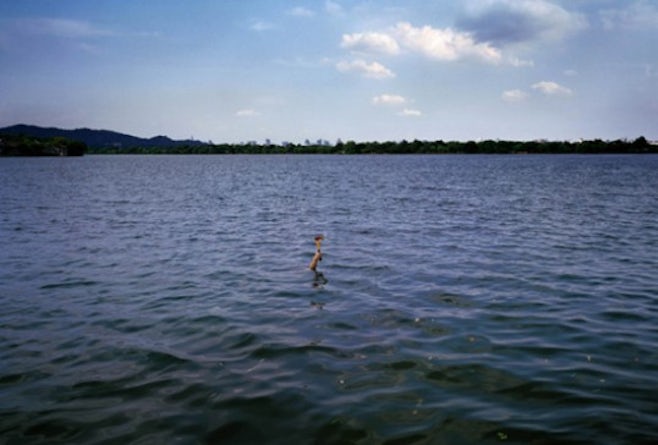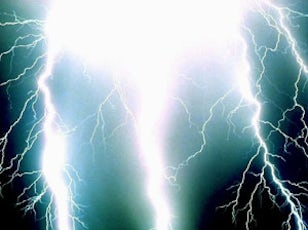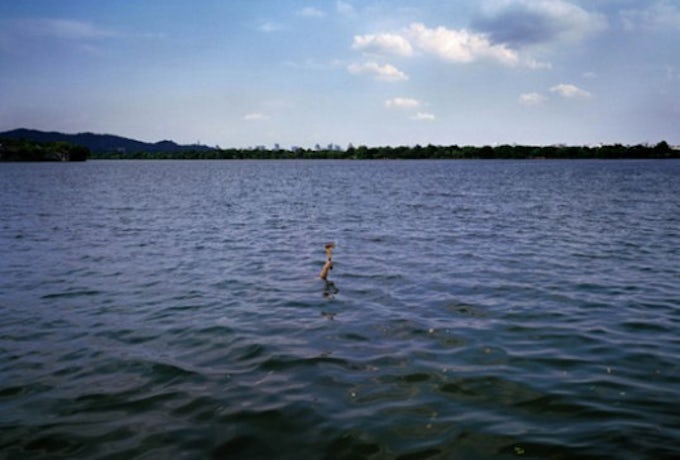
In Chen Xiaoyun’s first US solo show, ‘Faint’ (2006-07), at MC, the artist seems to ask us to consider how we derive meaning from narrative. His video work has a literary quality, though his use of overly wrought symbols empties this underlying narrative desire of any moral reward. Xiaoyun’s work is brave and humble, as his fundamental self-mockery reveals the cliché allure of the solitary male author’s journey. A more humorous Bas Jan Ader and a more self-critical Matthew Barney, Xiaoyun’s videos are studied and economic. It becomes clear as one spends time with the generous installation of his video work and the rich simplicity of his photographs that his subject – that of making – presents us with an ethics of art and life.
Xiaoyun divides the space of MC so as to enhance the displaced nature of his images. The four-channel video projection Several Moments Extending to the Night II (2004) utilizes one gallery wall and three temporary walls, which curl around the main space in an arc that warms the physical cube of the gallery and the patterned intersplicing of images within this video. Additionally, this installation offers a metaphor for the piece’s narrative betrayal and a visceral experience for the viewer of slipping in and out of its landscape. At its most basic, Xiaoyun’s work functions by this kind of slippage – between the symbolic and the conceptual, the contextual and the universal, the cynical and the hopeful, and the documentary and premonitory. Much of this is assisted by Several Moment’s constant sound of a passing train, which echoes throughout the space an becomes a soundtrack for the entire show.
In the smaller rectangular gallery to the right of the main space is the shorter video work Lash (2004). From the wall monitor comes the sound of a whip, which is a metronome for the series of still images, found footage, and video clips of night environments that comprise Lash ‘s horror film allusions. This sound feels contained, however, making it reminiscent of Nauman’s Stamping in the Studio , and, consequently, making the neighboring sound of Several Moments like hearing a train outside a city window. The gallery becomes a singular habitat of sounds and image projections.

In between the two video pieces, two photographs frame the entry of one gallery into the other. In Revolution(2005) an arm holding an axe is raised out of a vast body of water with a distant cityscape in the background. InBetween (2006) two characters in whimsical apparel and a gymnastic stance appear to be spotting a sought-after destination but behind them is a metropolis from which they have turned their gaze. There is a stolen sense of achievement in both of these images, which is the crux of Xiaoyun’s work and the humor in it. To this author there is no achieved space but a history of symbols that allows us to measure progress within it.
Rather than settle in the complacency of doing nothing when faced with ethical dilemmas of pursuit and progress, the work constantly puts forth symbols that it later diminishes into arbitrary signs. Xiaoyun has created his own language of symbols: snakes as insignia, water as vast or baptismal, branches and screws as mechanical parts, fireworks and flags as territorial claims, ponies as myth and fantasy, and blues and blacks and whites as reductions. Additionally, the way Xiaoyun uses these symbols cinematically recalls iconic cultural scenes. Here lies the slippage referred to earlier, where the conflation of narrative and symbol makes any understood cultural meaning absurd. There is a panning shot of an exercise machine, which appears like a promotional video, the camera scanning the contours of gears and legs; or a female’s legs stepping through leaves in a forest, which beckons a music video’s allure; or the absurdity of a nude male pulling himself up a horizontal ladder; or the shot of a male character lying on a shower floor spitting out screws at the drain. It is like some devastation has happened, but in being performed, the thing that was to have happened is happening. The ethics of the constant narrative drive and, consequent, narrative desire within Xiaoyun’s work are compelling as both humble commentary and cinematic thriller.
At once a structuralist and post-structuralist critique, Xiaoyun’s work is an argument for humanism in its most visceral sense. His landscapes are both rural and urban, his characters are both himself and doppelgangers, and his motifs are both everyday and overly cited with cultural references. As the sound of the passing train in Several Moments becomes more audible, we understand that we are somewhere specific but nowhere in particular. Yet, we have the need to constantly mark our territory. Among some of the more striking scenes are the Olympic torch being carried through a night street, a solitary officer staking a hilltop with a flag, or like Armstrong on the moon, a flag being held in silhouette to a nighttime cityscape. Xiaoyun’s images have the ability to navigate familiar terrain without relying on their cultural significance. In this he posits a post-colonial critique by inculpating our own narrative desire for resolve and territorial claim.
Xiaoyun’s work does an agile job at mining the personal without becoming nostalgic or subjective. The artist acknowledges the question of how to authentically claim the inherited pursuit of personal achievement – rewrite it and constantly rewrite it. Empty it of its extravagance, and retain its only true quality, that of indelibility. Xiaoyun’s work is economic and literary, sweet and cold. It has a humor that effectively strikes only the most intently listening. Like the ethics in Beckett’s statement, ‘I cannot go on, I will go on,’ in Faint Chen Xiaoyun continues reascribing his own imagery to defeat any stable understanding of these symbols’ significance as destinations or determinations.
– Danielle Adair Correll
